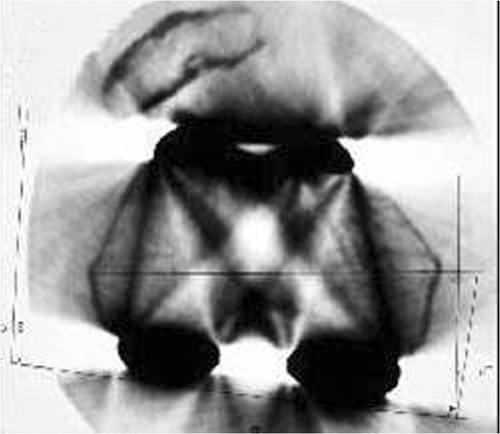Figures & data
Table I. Main characteristics of the navigated and non-navigated groups.
Figure 1. A preoperative CT scan of the lower femur was required to determine the posterior condylar angle with the original femoral component in place. In this example, the femoral component was implanted in internal rotation with a subluxated patella.

Figure 2. a) Peroperative view showing severe destruction of both condyles. b) The femoral pins are placed medially, so as not interfere with the preparation of the medullary canal. Two hemi-femoral head allografts were required to reconstruct the femoral condyles. [Color version available online.]
![Figure 2. a) Peroperative view showing severe destruction of both condyles. b) The femoral pins are placed medially, so as not interfere with the preparation of the medullary canal. Two hemi-femoral head allografts were required to reconstruct the femoral condyles. [Color version available online.]](/cms/asset/ceb3a999-4e66-4737-9c44-97f8912e6d46/icsu_a_323251_f0002_b.gif)
Figure 3. Operative view showing the placement of the beacons on the tibia and femur. [Color version available online.]
![Figure 3. Operative view showing the placement of the beacons on the tibia and femur. [Color version available online.]](/cms/asset/300b663d-6068-4b4b-8cbe-4a6aecbba83e/icsu_a_323251_f0003_b.gif)
Figure 4. Operative view showing the navigation of the tibial cut. [Color version available online.]
![Figure 4. Operative view showing the navigation of the tibial cut. [Color version available online.]](/cms/asset/a6bb9906-5b5c-4449-84ce-6ab1844568cc/icsu_a_323251_f0004_b.gif)
Figure 5. Screenshot showing the difference in height between the ideal cut (with reference to the level of the joint line) (blue line) and the actual bone cut through the remaining bone (yellow line). In this example, the bone defect was measured at 10 mm. [Color version available online.]
![Figure 5. Screenshot showing the difference in height between the ideal cut (with reference to the level of the joint line) (blue line) and the actual bone cut through the remaining bone (yellow line). In this example, the bone defect was measured at 10 mm. [Color version available online.]](/cms/asset/a3434899-6a06-4a7f-83a9-500f8c0cdda1/icsu_a_323251_f0005_b.gif)
Figure 6. Preoperative view showing the navigation of the distal femoral cut, with the cutting guide mounted on an intra-medullary jig. In the present system, two femoral angles were proposed (5° and 7°). If one of these angles was adequate, canal-filling femoral stems could be used; if neither of them was adequate, a thinner stem was used, allowing some degree of tilting until the correct angle was obtained. [Color version available online.]
![Figure 6. Preoperative view showing the navigation of the distal femoral cut, with the cutting guide mounted on an intra-medullary jig. In the present system, two femoral angles were proposed (5° and 7°). If one of these angles was adequate, canal-filling femoral stems could be used; if neither of them was adequate, a thinner stem was used, allowing some degree of tilting until the correct angle was obtained. [Color version available online.]](/cms/asset/b0234fba-e662-434b-9160-662ed4602ddb/icsu_a_323251_f0006_b.gif)
Figure 7. Cusum test showing that the values of the femoro-tibial axis were inside the decision interval (−3.2; +3.2). [Color version available online.]
![Figure 7. Cusum test showing that the values of the femoro-tibial axis were inside the decision interval (−3.2; +3.2). [Color version available online.]](/cms/asset/e3f48ae6-8dd9-4340-9672-c98cb47c358a/icsu_a_323251_f0007_b.gif)
Table II. Position of the components as measured on the postoperative X-rays. Mean and standard deviation (SD) are given for each measurement in the navigated and non-navigated groups. The patellar tilt was measured on a skyline view: It is the angle between a line connecting the anterior limits of the condyles and a line drawn through the prosthesis bone interface. If the angle is positive, the patellar angle is considered normal; if the angle is zero or reversed (luxation), patellar tilt is considered abnormal. The medial tibial angle was measured on an AP view of the upper tibia: It is the medial angle between the line drawn though the tibial baseplate and the tibial anatomical axis. The lateral femoral angle was measured on an AP view of the lower femur: It is the lateral angle between the line connecting the distal limits of the condyles and the femoral anatomical axis. The femoral slope was measured by the angle between the femoral anatomical axis and the line perpendicular to the tangent of the femoral component on a lateral view of the lower femur.